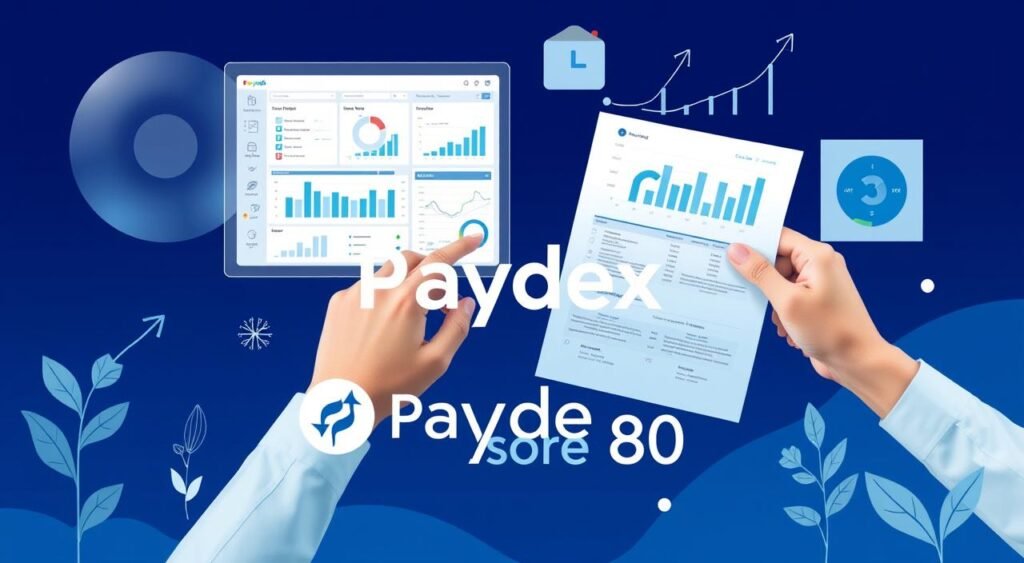Is your business credit score holding you back from growth opportunities? The PAYDEX score, a key metric in Dunn & Bradstreet ratings, can make or break your company’s financial future. This unique indicator, ranging from 1 to 100, reflects how your firm has paid its bills over the past year1.
A score of 90 or above signals excellent payment performance, while falling below 70 raises red flags. Understanding and improving your PAYDEX score is crucial for securing financing and fostering beneficial business relationships. Let’s dive into the essentials of credit score management and explore how to improve your PAYDEX score.
Did you know that maintaining a PAYDEX score of at least 75 shows low risk and a tendency to repay on time? Conversely, scores below 75 suggest a higher risk of late payments, and dipping below 40 is considered poor1. This score directly influences your ability to secure funding and establish trust with potential partners.
Interestingly, a perfect PAYDEX score of 100 indicates that a business consistently pays suppliers 30 days in advance1. This level of financial responsibility can open doors to better credit terms and financing options. By understanding the nuances of your PAYDEX score and implementing strategic improvements, you can significantly enhance your business’s creditworthiness.
Key Takeaways
- PAYDEX scores range from 1 to 100, with higher scores indicating better payment history
- Aim for a score of 75 or higher to demonstrate low risk to lenders and suppliers
- Early payments can boost your score, with 30-day advance payments earning a perfect 100
- At least three open tradelines are necessary to generate a PAYDEX score
- Regular monitoring and timely dispute resolution are crucial for maintaining a good score
- Payment history is the most significant factor in determining your business credit score
- Consider checking your business credit report with all three main business credit bureaus
Understanding the PAYDEX Score and Its Importance
The PAYDEX Score is a crucial tool for business credit building and financial responsibility. It’s a key metric that can significantly impact your company’s financial health and relationships with suppliers.
What is a PAYDEX Score?
A PAYDEX Score is a business credit score created by Dun & Bradstreet (D&B) to measure a company’s payment performance. This score ranges from 0 to 100, with higher scores indicating better payment practices2. It’s calculated based on your payment history with suppliers and vendors over the past two years3.
Why PAYDEX Matters for Your Business
Your PAYDEX Score plays a vital role in your business credit profile. It’s used by landlords, lenders, and suppliers to assess your creditworthiness. A good score can lead to better terms for leases, loans, and credit lines. Most businesses prefer working with companies that have a PAYDEX Score of 80 or higher, as it indicates timely payments2.
The PAYDEX Score Range Explained
Understanding the PAYDEX Score range helps you gauge your financial standing:
| Score Range | Risk Level | Payment Behavior |
|---|---|---|
| 80-100 | Low | Payments 0-30 days early |
| 50-79 | Medium | Payments 2-30 days late |
| 0-49 | High | Payments 31-120 days late |
A score of 80 means you’re paying invoices exactly on the due date. Scores above 80 indicate early payments, while scores below 80 suggest late payments23. By focusing on timely or early payments, you can improve your score and demonstrate strong financial responsibility.
The Fundamentals of Building Business Credit
Building business credit is a crucial step for any company looking to establish financial credibility. The process starts with obtaining a D-U-N-S Number from Dun & Bradstreet (D&B), which serves as your business’s unique identifier. This number is essential for generating a PAYDEX Score, which reflects how reliably your business pays its bills4.
To kickstart your business credit journey, focus on establishing payment experiences with suppliers. D&B requires at least three payment experiences from two different suppliers to generate your PAYDEX Score. Remember, larger and earlier payments have a more significant impact on your score.
Implementing effective debt repayment strategies is key to improving your business credit. Consider using business credit cards as a quick way to boost your score and access working capital. Invoices and Net D financing terms are excellent options for building credit without incurring interest5.
Payment history optimization plays a vital role in your credit-building efforts. Consistent on-time or early payments are crucial for maintaining a strong business credit profile. Regular monitoring of your credit reports helps you identify and address any issues promptly.
| Credit Building Method | Benefit | Consideration |
|---|---|---|
| Business Credit Cards | Fast improvement, working capital access | Careful management required |
| Invoices | Flexible financing, no interest | Requires diligent follow-up |
| Net D Financing | Improves D&B rankings, interest-free | Terms vary (Net 15, Net 30, etc.) |
| Vendor Relationships | Builds credit, secures necessary goods/services | Choose vendors that report to credit bureaus |
By focusing on these fundamentals and implementing smart debt repayment strategies, you can effectively build and improve your business credit score over time.
How Dunn & Bradstreet Ratings Impact Your Business
Dunn & Bradstreet (D&B) plays a crucial role in business credit reporting. Their ratings significantly influence your company’s financial opportunities and market credibility. Understanding D&B’s complex system is key to maintaining a strong business credit profile.
The Role of D&B in Business Credit Reporting
D&B provides comprehensive credit scores and ratings that lenders and suppliers use to assess your business’s creditworthiness. Their reports include various metrics, such as the PAYDEX Score, D&B Delinquency Predictor Score, and D&B Failure Score, each offering unique insights into your company’s financial health6.
Understanding Different D&B Credit Scores
D&B’s credit ratings are divided into two main categories: Financial Strength and Risk Indicator. The Financial Strength scale ranges from 5A for companies with over $50 million net worth to HH for those under $5,000. The Risk Indicator provides a composite credit appraisal from 1 (minimal risk) to 4 (high risk)67.
| Financial Strength | Net Worth | Risk Indicator | Risk Level |
|---|---|---|---|
| 5A | $60+ million | 1 | Minimal risk |
| 4A | $25-60 million | 2 | Low risk |
| 3A | $12-25 million | 3 | Greater than average risk |
| 2A | $2.5-12 million | 4 | Significant level of risk |
How D&B Ratings Affect Financing Opportunities
Your D&B ratings directly impact your ability to secure favorable financing terms. Businesses with strong D&B ratings are more likely to obtain better interest rates and credit terms from lenders and suppliers6. The Supplier Evaluation Risk Rating and Financial Stress Score Percentile are particularly important, as they indicate your company’s financial stability and likelihood of meeting obligations8.
To improve your D&B ratings, focus on maintaining a good vendor relationship maintenance and managing your credit utilization ratio. Timely payments, avoiding credit maxing, and promptly addressing any errors in your credit report are essential strategies. Remember, a high PAYDEX Score (80-100) is a strong indicator of your business’s creditworthiness6.
Establishing a Strong Payment History
A robust payment history forms the bedrock of a stellar PAYDEX Score. Your timely payment habits demonstrate financial responsibility and effective cash flow management. The PAYDEX score, ranging from 1 to 100, reflects your business’s payment performance, with most companies falling between 30 and 809.
Consistency is key when it comes to bill payments. Paying early or on time not only boosts your score but also showcases your business’s reliability. Remember, even a single late payment can tarnish your credit profile.
To maintain a clean payment history, consider implementing these strategies:
- Utilize cash flow forecasting to anticipate potential financial challenges
- Set up automatic payments for recurring bills
- Explore quick funding sources like invoice factoring for unexpected expenses
- Regularly review your credit report to catch and dispute any errors promptly
Your payment history significantly impacts your Delinquency Predictor Class, which ranges from 1 to 5 and predicts the likelihood of severe payment delinquencies over the next year9. By maintaining strong timely payment habits, you can positively influence this predictor and other crucial D&B ratings, such as the Financial Stress Class and Supplier Evaluation Risk Rating9.
Remember, your PAYDEX Score is a reflection of your business’s financial responsibility. By prioritizing on-time payments and actively managing your credit profile, you’re setting your business up for long-term success and favorable financing opportunities.
Strategies for Early Bill Payment
Paying bills early is a crucial debt repayment strategy that can significantly boost your PAYDEX Score. By settling invoices before their due dates, you’re not just maintaining good vendor relationships but also enhancing your business credit profile.
The Impact of Early Payments on Your PAYDEX Score
Early payments can push your PAYDEX Score above 80, signaling low risk to potential creditors. Scores between 80 to 100 indicate on-time or early payments, while settling exactly on the due date caps your maximum score at 8010. Consistently paying early, especially for larger amounts, can have a substantial positive impact on your score.
Setting Up Automatic Payments
Implementing automatic payments is an effective way to ensure consistent early payments. This system helps you avoid late fees and maintains a steady cash flow. Set up automatic transfers a few days before the due date to give yourself a buffer for any potential banking delays.
Negotiating Payment Terms with Vendors
Effective vendor relationship maintenance includes negotiating favorable payment terms. Discuss options like extended payment periods or early payment discounts. These arrangements can help you manage cash flow while still paying early, positively impacting your PAYDEX Score.
Remember, Dun & Bradstreet uses at least three Trade Experiences from a minimum of two reporting parties to calculate a Paydex Score10. Ensure your vendors report your payment history to D&B to maximize the benefit of your early payment strategy11.
Monitoring and Disputing Errors in Your Credit Report
Credit monitoring is a crucial aspect of financial responsibility for business owners. Regular checks of your business credit report help maintain an accurate PAYDEX Score. While errors in credit reporting are rare, they can significantly impact your credit scores and financial opportunities12.
Business owners don’t have the same rights as consumers when it comes to free annual credit reports13. This makes proactive credit monitoring even more important. Errors on your business credit report can lead to higher insurance premiums, increased financing rates, loan rejections, and difficulties securing leases13.

Three major business credit bureaus – Experian Small Business, Equifax Small Business, and Dun & Bradstreet – compile your business credit information1412. These reports include company details, historical data, operational information, and payment history14.
If you spot an error, take these steps:
- Review your reports thoroughly
- Document any errors
- Contact the supplying business
- Reach out to the credit bureau with errors
When disputing errors, provide documentation to support your claim12. Remember, different bureaus may not report the same information, so check reports from all three12.
| Bureau | Dispute Contact |
|---|---|
| Experian Small Business | Experian Small Business Disputes |
| Equifax Small Business | Equifax Small Business Disputes |
| Dun & Bradstreet | Dun & Bradstreet Disputes |
Continuous credit monitoring is essential for maintaining good credit health14. By staying vigilant and addressing discrepancies promptly, you protect your business’s financial standing and future opportunities.
Maintaining Active Credit Lines
Keeping your credit lines active is crucial for a strong PAYDEX Score. A robust credit profile requires regular financial activity and smart management of your accounts. Let’s explore how you can effectively maintain your credit lines and boost your business credit building efforts.
The Importance of Regular Credit Activity
Regular credit activity shows ongoing financial responsibility. To start receiving a PAYDEX score, you need at least three active tradelines reporting to Dun & Bradstreet regularly15. This activity helps lenders assess your creditworthiness and can lead to better terms with potential creditors16.
Balancing Credit Utilization
Your credit utilization ratio plays a significant role in your business credit profile. It’s advisable to keep your debt-to-credit limit ratios at 50% or below to avoid appearing overextended16. For even better predictive ratings, aim to keep credit utilization below 25%15.
| Credit Utilization | Impact on Credit Profile |
|---|---|
| Below 25% | Excellent |
| 25% – 50% | Good |
| Above 50% | Potentially Negative |
Diversifying Your Credit Mix
A diverse credit mix can positively impact your overall business credit profile. Consider setting up lines of credit with multiple vendors to create various trade lines reporting on your Dun and Bradstreet credit reports17. This diversity can help your business credit score rise faster and demonstrate your ability to manage different types of credit responsibly.
Remember to monitor your business credit status regularly by requesting reports from Dun & Bradstreet17. This practice allows you to track changes, make timely improvements, and ensure your credit profile accurately reflects your financial health15. By maintaining active credit lines and following these strategies, you’ll be on your way to building a strong business credit profile.
Building Relationships with Suppliers and Vendors
Strong vendor relationships are key to business credit building. By fostering trust with your suppliers, you pave the way for better payment terms and positive credit reporting. This approach not only aids in vendor relationship maintenance but also enhances your overall financial health.

- Communicate openly about your payment capabilities
- Pay bills on time or early
- Negotiate favorable terms
- Request trade references from long-standing partners
Remember, your PAYDEX score, which ranges from 1 to 100, directly impacts your ability to secure business funding and credit cards. Higher scores increase your chances of qualifying for loans and raising credit limits18.
Consistently paying bills on time is crucial for boosting your credit score. Late or missed payments can significantly harm your creditworthiness18. By maintaining positive vendor relationships, you’re more likely to receive favorable terms and timely reporting of your good payment habits to credit bureaus.
| Action | Benefit |
|---|---|
| Early payments | Higher PAYDEX score |
| Open communication | Better payment terms |
| Regular orders | Increased vendor trust |
| Requesting trade references | Improved credit profile |
By focusing on vendor relationship maintenance, you’re not just improving your business credit building efforts. You’re creating a network of trusted partners that can support your company’s growth and financial stability in the long run.
Leveraging Trade References to Boost Your Score
Trade references play a vital role in payment history optimization and business credit building. These are suppliers or vendors who report your payment experiences to Dun & Bradstreet (D&B). By actively managing trade references, you can significantly improve your PAYDEX Score.
What Qualifies as a Trade Reference
A trade reference is a business relationship with a supplier or vendor lasting six months to a year. This timeframe ensures a meaningful payment history19. Trade references can’t include landlords, banks, credit card companies, or related businesses19. Ideal references come from the same industry, providing a more accurate assessment of your creditworthiness20.
How to Request Trade References
When seeking trade references, focus on vendors with whom you have a positive payment history. Approach them professionally, explaining the importance of their reference for your business credit. Remember, strong trade references can help you negotiate better terms with new suppliers20.
Reporting Positive Payment Experiences to D&B
D&B offers CreditBuilder services for submitting trade references. CreditBuilder Plus allows 12 references yearly, while Premium enables unlimited submissions19. Adding trade references can enhance your PAYDEX score, Financial Stress Score, and Delinquency Predictor Score21. This proactive approach to business credit building can lead to improved credit limit recommendations and better supplier risk ratings21.
“Leveraging trade references is a powerful strategy for optimizing your payment history and building robust business credit.”
By consistently managing your trade references and maintaining positive payment experiences, you’re setting your business up for stronger credit scores and better financing opportunities.
Advanced Techniques for PAYDEX Score Improvement
Boosting your PAYDEX score requires strategic credit score management and financial responsibility. To take your efforts to the next level, consider these advanced techniques.
Timing large payments can significantly impact your score. Plan to make substantial payments just before your reporting date to showcase a lower credit utilization ratio. This strategy demonstrates your ability to manage credit effectively.

Proactively manage credit across multiple accounts. Spread your credit usage evenly to maintain a healthy overall utilization rate. This approach shows lenders you’re adept at handling various credit lines responsibly.
Consider alternative financing methods like invoice factoring. This can help maintain consistent early payments, even during cash flow fluctuations. Early payments are crucial for a high PAYDEX score, reflecting positively on your financial responsibility.
Leverage D&B’s credit-building packages to submit and verify payment information directly. This ensures accurate reporting and can expedite the process of improving your score. Remember, building a strong PAYDEX score takes time and consistent effort.
| Advanced Technique | Impact on PAYDEX Score |
|---|---|
| Strategic payment timing | Lowers credit utilization ratio |
| Multi-account credit management | Demonstrates diverse credit handling |
| Invoice factoring | Enables consistent early payments |
| D&B credit-building packages | Ensures accurate, timely reporting |
Remember, building business credit requires forming a business entity and establishing a profile with major business reporting bureaus22. By implementing these advanced techniques and maintaining good financial practices, you’ll be well on your way to a robust PAYDEX score.
Conclusion
Improving your PAYDEX score is crucial for your business’s financial health. By understanding Dunn & Bradstreet ratings and implementing strategic practices, you can boost your creditworthiness. Remember, consistent early payments and active credit management are key to achieving a higher score23.
Building strong relationships with suppliers and leveraging trade references can significantly impact your PAYDEX score. It’s important to note that D&B gathers information from numerous sources, including millions of websites, to assess your business credit24. Regular monitoring and prompt error resolution are essential steps in maintaining an accurate credit report.
While quick improvements are possible, building a robust PAYDEX score is a long-term process. It reflects your overall financial responsibility and can greatly influence your ability to secure favorable credit terms. Keep in mind that personal credit can affect your business credit, especially for small business owners23. By following these strategies and staying informed about how to improve your PAYDEX score, you’ll be well-positioned for financial success in the competitive business landscape.
FAQ
What is a PAYDEX Score?
Why is the PAYDEX Score important for businesses?
How can I establish and build business credit?
What is the role of Dun & Bradstreet (D&B) in business credit reporting?
How can I maintain a strong payment history?
How do early payments affect my PAYDEX Score?
Why is it important to monitor my business credit report?
How can I maintain active credit lines?
How can I build relationships with suppliers and vendors?
What are trade references, and how do they impact my PAYDEX Score?
Are there any advanced techniques for improving my PAYDEX Score?
Source Links
- PAYDEX Score: The Dun & Bradstreet Business Credit Rating – https://www.nav.com/business-credit-scores/dun-bradstreet-paydex/
- PAYDEX Score: The Only Ultimate Guide You Need To Read – https://www.forbes.com/advisor/credit-score/paydex-score/
- Understanding the Paydex Score – https://www.businessinsider.com/personal-finance/credit-score/what-is-paydex-score
- Understanding the Three Major Business Credit Bureaus – https://www.score.org/resource/article/understanding-three-major-business-credit-bureaus
- How To Improve Dun And Bradstreet Ratings | Improving Public Image – https://businesslendingblueprint.com/content/learn-how-to-improve-dun-and-bradstreet-ratings/
- Dun and Bradstreet Rating Guide | Bankrate – https://www.bankrate.com/credit-cards/business/what-is-db-rating/
- Dun & Bradstreet – https://www.dataservice.lv/en/rating.html
- 5 Ways to Improve Your Dun & Bradstreet Business Credit Report – https://www.creditsuite.com/blog/5-ways-to-improve-your-dun-bradstreet-business-credit-report/?srsltid=AfmBOoo0LyWmoB-u3fqSYxOIoslhKwysNb6cqYVdsONlisBBnuQRTsAr
- D&B Report – Dun and Bradstreet Business Credit Report – https://northshoreadvisory.com/business-credit/business-credit-reports/dun-and-bradstreet-business-credit-report/
- Paydex Score: Everything You Need to Know – https://paymentcloudinc.com/blog/paydex-score/
- 5 Ways to Improve Your Dun & Bradstreet Business Credit Report – https://www.creditsuite.com/blog/5-ways-to-improve-your-dun-bradstreet-business-credit-report/?srsltid=AfmBOop5uv3viGzqSSUPhhU13oV8qRaVKuDenND4I_02GJc9JZwp-sYF
- How to Dispute Errors on Your Credit Report | OnDeck – https://www.ondeck.com/resources/dispute-errors-credit-report
- Correcting Incorrect Information on Your Business Credit Reports | Nav – https://www.nav.com/blog/correcting-incorrect-information-on-your-business-credit-reports-33860/
- How to Dispute Errors on Your Credit Report – The Business Backer – https://www.businessbacker.com/blog/dispute-errors-credit-report/
- How to Improve Your Dun and Bradstreet Score/Paydex Ratings – https://planning.net/business/credit/bureaus/dnb/paydex/
- 5 Ways to Improve Your Dun and Bradstreet Rating – https://businesscreditblogger.com/2012/08/08/dun-and-bradstreet-rating/
- Dun & Bradstreet Business Credit Score Guide | TRUiC – https://howtostartanllc.com/business-credit/dun-bradstreet-business-guide
- Dun & Bradstreet Business Credit and Tradeline Guide – https://planning.net/business/credit/bureaus/dnb/
- What Is a Trade Reference? | eCredable – https://business.ecredable.com/resources/blog/what-is-a-trade-reference
- What is a Trade Reference Meaning | Credit Application Examples – https://www.emagia.com/blog/trade-references/
- How Dun & Bradstreet Credibility Corp. CreditBuilder Works – https://businesscreditblogger.com/2013/11/05/dun-and-bradstreet-credit-builder/
- Unsecured Startup 0% Business Credit Cards! Personal Lines! Credit Suite! Lending Tree! – https://www.unsecuredstartupbusinessloans.com/2016/12/
- What Is a Good Business Credit Score? | Nav – https://www.nav.com/resource/what-is-a-good-business-credit-score/
- The Astonishing Upside of Dun & Bradstreet (D&B) – https://www.linkedin.com/pulse/astonishing-upside-dun-bradstreet-db-j-david-green

